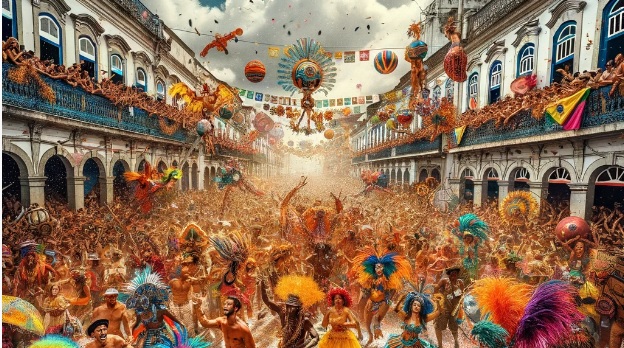Street blocks in brazilian carnival
interweaving joy, transformation and social inclusion
DOI:
https://doi.org/10.60144/v5i.2024.115Keywords:
Carnival, Cultural assets, Social inclusion, Information ScienceAbstract
Objective: The aim of this study is to understand how street parades in the Brazilian carnival contribute to integration, equality and the active participation of historically excluded groups in Brazilian cultural life. In addition, it examines how Information Science (IS), with its transdisciplinary and multicultural nature, through interaction with various areas of knowledge, can contribute to the preservation of the cultural heritage produced by the event. Method: The research method consists of a brief literature review focusing on scientific data obtained between 2022 and 2023 through database searches. We will carry out a qualitative analysis and case study. Results: It was found that the inclusive street blocks present at the Brazilian carnival promote the cultural, social and economic development of the groups surveyed and are a cultural asset, essential for building the country's cultural identity. Conclusions: The event generates a number of positive social impacts, given that participation in carnival contributes to increased self-esteem and a sense of belonging, especially for marginalised groups, promoting social inclusion and respect for social diversity. It also aims to understand the economic and social impact of the festival in Brazil.
Downloads
References
ALBIN, Ricardo Cravo. Escolas de samba. Textos Escolhidos de Cultura e Arte Populares, Rio de Janeiro, v. 6, n. 1, p. 249-255, 2009. DOI: 10.12957/tecap.2009.12174. Disponível em: https://www.e-publicacoes.uerj.br/tecap/article/view/12174. Acesso em: 23 set. 2024.
ARANTES, Nélio. Pequena história do Carnaval no Brasil. Revista Portal de Divulgação, n. 29, n. 3, p. 6-20, 2013. Dispnível em: https://revistalongeviver.com.br/anteriores/index.php/revistaportal/article/view/327/0. Acesso em: 23 set. 2024.
BAHIA. Biblioteca Setorial do Cecult. Universidade Federal do Recôncavo da Bahia. A origem do carnaval. Disponível em: https://www1.ufrb.edu.br/bibliotecacecult/noticias/228-a-origem-do. Acesso em: 03 jul. 2024.
BRASIL. Lei n° 14.845, de 24 de abril de 2024. Reconhece como manifestação da cultura nacional os blocos e as bandas de carnaval. Brasília, DF: Presidência da República, 1990.
BRASIL. Ministério do Turismo. Inventário da Oferta Turística – Estratégia de Gestão. Brasília: Ministério do Turismo, 2023.
BRASIL. Secretaria de Comunicação Social. Carnaval deve movimentar R$ 9 bilhões no setor de turismo, aponta CNC. Brasil, 2024. Disponível em: https://www.gov.br/secom/pt-br/assuntos/noticias/2024/01/carnaval-deve-movimentar-r-9-bilhoes-no-setor-de-turismo-aponta-cnc#:~:text=A. Acesso em: 10 ago. 2024.
CABRAL, Sérgio. As escolas de samba: o que, quem, como, quando e por que. Rio de Janeiro: Fontana, 1974. 159 p.
CAPURRO, Rafael; HJØRLAND, Birger. O conceito de informação. Perspectivas em Ciência da Informação, Belo Horizonte, v. 12, n.1, p. 148-207, jan./abr. 2007. Disponível em: https://periodicos.ufmg.br/index.php/pci/article/view/22360. Acesso em: 10 ago. 2024.
CNC (Brasil). Pesquisa: Carnaval 2024. 2024. Confederação Nacional do Comércio de Bens, Serviços e Turismo. Disponível em: https://portaldocomercio.org.br/a-cnc/. Acesso em: 03 jul. 2024.
COELHO, Teixeira. Dicionário crítico de política cultural. São Paulo: Iluminuras, 1997.
CRESWELL, John W. Projeto de pesquisa: métodos qualitativo, quantitativo e misto. 3. ed. Porto Alegre : Artmed, 2010.
FREYRE, Gilberto. Casa Grande & Senzala. 48. ed. São Paulo: Global, 2003.
GALVÃO, Taís Freire; PEREIRA, Mauricio Gomes. Revisões sistemáticas da literatura: passos para sua elaboração. Epidemiologia e serviços de saúde, Brasília, v. 23, n. 1, p. 183-184, 2014. Disponível em: http://scielo.iec.gov.br/scielo.php?script=sci_arttext&pid=S1679-49742014000100018. Acesso em: 01 jul, 2024.
GÓES, Margarete Sacht; MACEDO, Leiliana Zucoloto. Equipamentos culturais da Grande Vitória-ES: documentação e produção artístico-cultural e educativa local. Revista Educação, Artes e Inclusão. Florianópolis, v.18, p.1-26, 2022. Disponível em: https://revistas.udesc.br/index.php/arteinclusao/article/view/17726. Acesso em: 01 jul, 2024.
GRAND JÚNIOR, João. Cidade, cultura e desenvolvimento: perspectivas e desafios para a economia cultural-criativa do samba-carnaval carioca. Diálogo com a Economia Criativa, Rio de Janeiro, v. 1, n. 1, p. 29-46, 2016. Disponível em: https://www.gov.br/turismo/pt-br/search?SearchableText=turismo%20e%20carnaval. Acesso em: 01 jul, 2024
GUEDES, Maria Tarcila Ferreira; MAIO, Luciana Mourão. Bem cultural. In: GRIECO, Bettina; TEIXEIRA, Luciano; THOMPSON, Analucia (Orgs.). Dicionário IPHAN de Patrimônio Cultural. 2. ed. ver. ampl. Rio de Janeiro, Brasília: IPHAN/DAF/Copedoc, 2016. (verbete).
KESTRAA. Carnaval e o comércio exterior: quais os impactos para o setor. Disponível em: https://www.kestraa.com.br/carnaval-e-o-comercio-exterior-quais-os-impactos-para-o-setor/. Acesso em: 12 mar. 2024.
LAKATOS, Eva Maria; MARCONE, Marina de Andrade. Metodologia científica. 3. ed. São Paulo: Atlas, 2003.
MATTA, Roberto da. Carnavais, malandros e heróis: para uma sociologia do dilema brasileiro. 6. ed. Rio de Janeiro: Rocco, 1997.
NATIONAL GEOGRAPHIC BRASIL. Carnaval: qual a origem dos blocos de rua? National Geographic Brasil, Rio de Janeiro, 2023. Disponível em: https://www.nationalgeographicbrasil.com/historia/2023/02/carnaval-qual-a-origem-dos-blocos-de-rua. Acesso em: 12 mar. 2024.
RIBEIRO, Jussélio Rodrigues; MOURÃO, Luciana. Carnaval como instrumento de inclusão social de pessoas com deficiência. Estudos e Pesquisas em Psicologia, Rio de Janeiro, v. 16, n. 03, p. 736-756, jan. 2016. Disponível em: http://pepsic.bvsalud.org/pdf/epp/v16n3/n16a05.pdf. Acesso em: 03 jul. 2024.
UNESCO. Basic Texts of the 2003 Convetion for the Safeguarding of the Intangible Cultural Heritage. 2022 edition. Paris, 2003.
VIANNA, Letícia C. R. Patrimônio Imaterial. In: GRIECO, Bettina; TEIXEIRA, Luciano; THOMPSON, Analucia (Orgs.). Dicionário IPHAN de Patrimônio Cultural. 2. ed. rev. ampl. Rio de Janeiro, Brasília: IPHAN/DAF/Copedoc, 2016. (verbete). ISBN 978-85-7334-299-4.
YIN, Robert K.; HERRERA, Cristian Matheus. Estudo de caso: Planejamento e métodos. 5.ed. Porto Alegre: Bookman, 2001.

Downloads
Additional Files
Published
How to Cite
License
Copyright (c) 2024 Marcia Aparecida Bolina, Fabricio Ziviani

This work is licensed under a Creative Commons Attribution 4.0 International License.
Qualquer usuário tem direito de:
- Compartilhar — copiar, baixar, imprimir ou redistribuir o material em qualquer suporte ou formato
- Adaptar — remixar, transformar, e criar a partir do material para qualquer fim, mesmo que comercial.
De acordo com os seguintes termos:
- Atribuição — Você deve dar o crédito apropriado, prover um link para a licença e indicar se mudanças foram feitas. Você deve fazê-lo em qualquer circunstância razoável, mas de maneira alguma que sugira ao licenciante a apoiar você ou o seu uso.
- Sem restrições adicionais — Você não pode aplicar termos jurídicos ou medidas de caráter tecnológico que restrinjam legalmente outros de fazerem algo que a licença permita.














